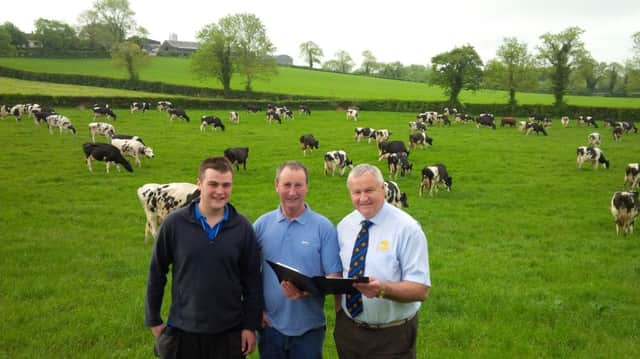High yielding cows performing well at grass


Research has demonstrated that a winter calving, moderate input – high output system (8,500 herd average), based on grazed grass and grass silage, is the most robust system for NI dairy farmers across a range of milk prices. But regardless of your system, the level of technical efficiency is critical in these difficult market conditions.
The Taughlumny Holstein Herd, owned by William and John Gamble, Donaghcloney, Co. Armagh, is an excellent example of efficient milk production from a high yielding herd. Their 120 cow herd has a rolling herd average of 8,947 litres per cow in the McLarnon Milk Manager Costings, provided by Promar. Crucial to the herd’s financial performance, this level of output is achieved from 2.2 tonnes of concentrates fed per cow, which is equivalent to 4,386 litres of milk produced from all forages. Even with current milk prices, their 12 month rolling margin over purchased feed stands at 14.7 pence/litre.
Advertisement
Advertisement
The Gamble Family run a simple system but do so very efficiently. Growing and utilizing quality forage lies at the heart of the business. This year the predominantly winter calving herd were turned out to grass by day on March 17, with the entire herd grazing full-time by mid-April. Fields are grazed down tightly to ensure a leafy sward for the next rotation, and pre-mowing is used to maintain pasture quality when tight grazing is a challenge. Fields are generally small (2-5 acres) so strip grazing in 12 hour allocations works well.
This year’s first cut silage was mowed on 13th May, tedded, and lifted the following day. A recent sample analysed at 26.7% DM, 11.7 MJ ME and 12.5% crude protein, and is predicted to support M+10 litres. Last winter, the milking herd were housed in a single group and fed a partial TMR of silage, 0.5kg straw and 5kg McLarnon’s 20% Supreme Blend (target M+22 litres), topping up in the parlour with McLarnon’s 18% Quality Max-Yield Dairy Nuts at 0.45 kg/litre. In April, cows were averaging 31.7 litres per day, taking M+18 litres from grass, and fed to yield through the parlour with McLarnon’s 16% Maize Graze Dairy Nuts at 0.45 kg/litre. Buffer feeding with silage alone is undertaken only when grass is in short supply.
To maximise grass production, 20-30 acres are reseeded every year with the top-performing varieties on the NI Recommended List. Fields are soil sampled every three years to check pH and nutrient levels. To date, P and K levels have been adequate (index 2 & 3) although some liming has been needed to keep soil pH at 6.0-6.5.
High overhead costs can cripple even the most efficient dairy farms, but this is another area where the Gamble farm excels. With the exception of some additional slurry storage, there have been no major investments in cattle accommodation over recent years. All silage harvesting and most of the slurry spreading is undertaken by a local contractor, with only essential machinery kept on the farm.
Advertisement
Advertisement
In conclusion, NI dairy farmers can improve their herd performance by targeting increased milk from forage, and keeping a close eye on overheads, without making significant changes to the overall farming system. The Gamble farm demonstrates that high yielding herds can produce milk economically from grazed grass and good silage.
If you would like advice on grazing your dairy cows, contact Dr Ronald Annett, Ruminant Technical Manager at McLarnon Feeds, on 028 7965 0321, or alternatively speak to your local McLarnon Technical Sales Rep.